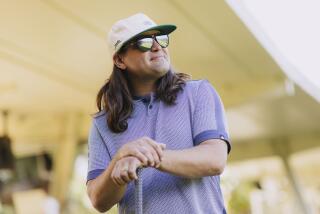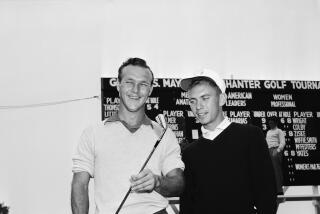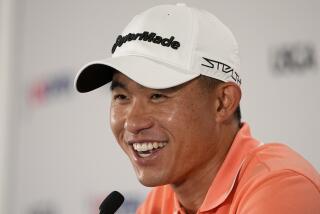O’Meara Left His Mark on PGA Tour Last Year : He Was Runner-up to Watson in Earnings and Was Third in Vardon Trophy for Scoring
- Share via
Mark O’Meara finished the 1984 professional golf tour second to Tom Watson in money winnings and third to Calvin Peete and Jack Nicklaus in scoring average. Those are two of golf’s most coveted prizes, the Arnold Palmer Award for top money winner and the Vardon Trophy for scoring average.
A case could be made for O’Meara in both.
He won $465,873, the third highest figure in PGA history, and only $10,387 behind Watson’s winnings of $476,260.
“I certainly don’t want to sound like I’m detracting from Tom, after all, he had three wins to my one and he and Jack and Lee (Trevino) are the elite players in the world,” O’Meara said, “but I did spot him that hundred grand at Tucson before the season really started, and then nearly caught him. I would say that no one did what I did the last three-quarters of the year.”
Watson won $100,000 in the Tucson Match Play championship after being seeded all the way to the fifth round without having to play a match. Actually, O’Meara only spotted Watson $99,250 because he collected $750 after losing in the first round.
O’Meara had one last chance to pass Watson last year when the latter didn’t enter the Pensacola Open, final event on the 1984 schedule, but he missed the cut.
“I was in Japan the next Tuesday to play in the (USA vs. Japan) team matches and the first time I saw Tom was on the bus to the course. I said, ‘Congratulations, Tom, on winning the money list and being named player of the year.’ He looked at me sort of surprised and then he kind of laughed and said, ‘Thanks for respecting your elders.’ I said, ‘I wanted to beat you, partner. I just didn’t make it.’ ”
As to the scoring, O’Meara feels he played more and tougher courses than Peete or Nicklaus. He played in 32 to 25 for Peete and only 13 for Nicklaus.
“Peete’s a fantastic player, straighter than anybody in the game, but if you analyze the courses I played against the ones he played, I think my scoring represents a better figure. Calvin did not play some of the longer courses, because he feels he doesn’t hit it long enough off the tee (Peete is not in the top 50 in driving distance, but is first in driving accuracy). He went to San Antonio (for the Texas Open) and shot those low scores (67-67-66-66) on that par-70 course and packed it in for the year. And Jack wasn’t eligible for the Vardon because he didn’t play enough rounds.”
A minimum of 80 rounds is necessary. O’Meara played 111, Peete 82 and Nicklaus 52.
“In my own heart, I’m very pleased at what happened to me last year,” said O’Meara, who had only one win, the Greater Milwaukee Open in September in which he beat Watson by five shots, but was second five times, third three times, had 15 top 10 finishes, and set a tour record for birdies with 419. For this, he was named Golf Digest’s most improved player.
It was not a difficult choice. He had increased his earnings $396,519 from a disappointing $69,354 that left him No. 76 on the 1983 money list.
Now comes 1985. O’Meara has been a goal-oriented golfer since the days he led Mission Viejo High School to the CIF Southern Section and state high school championships a decade ago--and he has some definite goals for this year: “I may never have a year like 1984, winning so much money with all those high finishes,” he said, “but this year I’d like to win at least two tournaments, and at least one major. I’m in all four of them (U.S. Open, Masters, British Open and PGA) for the first time.”
This week he will be playing in the Los Angeles Open at Riviera, and that poses some added burden to the young professional.
“It’s one thing to be playing in front of your old friends, in your hometown, and know everyone is pulling for you,” he said, “but there’s a minus when you consider all the intrusions into your time and space.
“Like when some guy walks up and says, ‘Hi, Mark, remember me, I’m so and so from so and so,’ and he expects me to smile and say, ‘Hey, sure, I remember,’ when maybe I’m trying to get over having just made a bogey. I don’t want to look like a sourpuss when I don’t hit a good shot, but it’s a real aggravation to have some guy interrupt your concentration. I know every guy who comes up like that is probably rooting for me, and in the right circumstance I’d probably be glad to chat with him, but it can be a real test during a tournament. It’s tough enough out there anytime, but I think it’s tougher when you’re playing near home.”
Going into his third tournament of the new season, O’Meara hopes he can block out all the outside interferences at Riviera. At the Hope Classic, he had four rounds in the 60s, but had an uncharacteristic 76 in the wind on Saturday and finished tied for 20th. That was better than he did last week at Phoenix, where he shot 70-76 and missed the cut.
When a player suddenly goes from winning $69,354 to $465,873 in a single year, like O’Meara did last year, there has to be a reason. O’Meara is quick to acknowledge his: “I can give it to you in two words: Hank Haney. Without his knowledge, and what he taught me the last two years, I wouldn’t have got to where I’m at now. There’s not a doubt in my mind about that.”
Haney is O’Meara’s golfing guru. Although he is now head professional at the Sweetwater Country Club, home of the LPGA, just outside Houston, he often travels with O’Meara, lives for a month at a time at his home in Palm Desert, follows him hole to hole in tournaments and talks with him almost daily on the telephone. And when Haney can’t get away, O’Meara is likely to be at Sweetwater, having his swing checked and rechecked. Unlike most famous teachers, such as Bob Toski, Peter Kostis, Harvey Penick or Jack Grout, Haney is not an oldtimer who has had the game rub off on him after decades on the fairways. He is only 29, a year older than his protege, O’Meara.
“I guess it was sort of fate, my meeting Hank. I was at Pinehurst, for the World Hall of Fame tournament toward the end of ‘82,” O’Meara said. “I’d had a pretty good first year on the tour in ‘81, making rookie of the year, nearly winning at Tallahassee (he lost a playoff to Dave Eichelberger), and all that, but I ran into a slump in ’82. I’d only won about $28,000 or so, not enough to come close to making expenses, when I got to Pinehurst in September.
“I was hitting it terrible. I had 75 in the first round and I was spraying it so bad I couldn’t find the golf ball. I was out on the range, still hitting it terrible, when I noticed a guy watching me. I knew he was one of the young pros, so I said, ‘What do you think? I need help, don’t I?’ He said, ‘I’ll get a guy who can help you,’ and two minutes later he introduced me to Hank Haney. He said, ‘What’s the problem?’
“I told him I couldn’t find the golf ball after I’d hit it. He watched me a while and then said, ‘Let’s go in and have a soft drink and talk about it.’ That impressed me. He didn’t have one of those snap answers, like ‘turn your hand over more’, or ‘loosen your knee’, or something like that. He explained to me that I needed to get my swing more on a plane, get it more rounded. He showed me how I was too upright, how that led to either slicing or duck hooking. He said the way I was swinging, it required too perfect timing to hit the ball pure every time, that I should get a swing that I could repeat.”
O’Meara was so impressed with the young man that he invited him to spend a month with him over the winter.
“Hank told me the changes wouldn’t make for an instant success, but that if I took my time and gave it a shot, his ideas couldn’t help but make me a better golfer. One day I was hitting balls, early last year, when Hank said, ‘You’re on your way.’ Well, you’ve seen what’s happened since then. Now, if I hit a poor shot, or have a poor round, I don’t panic like I did before I met Hank. Now I can either call him, or I take a look at my video cassettes to see how I’m supposed to be doing. I’m a strong believer in watching myself on film.
“He’s given me a lot of confidence, too. When I’m hitting it good, I don’t think there’s anyone who can hit it much better. To me, Lee Trevino is the best ball striker in the game. He may look different when he sets up in that funny open stance of his, but when his club head makes contact with the ball, it’s the same every time. Solid. That’s what I want, to hit it solid every time. With the swing Hank is teaching me, I think I can do it.”
A sturdy (6-0 180), round-faced Irishman, O’Meara has had one success after another since the day his family moved into a home next to the Mission Viejo Country Club course and he decided he liked the game they were playing in his backyard. He was 13 at the time.
His first objective was to make the high school varsity as a freshman. He did. In his junior year the Diablos won the state championship.
His next objective was to earn a college scholarship and he did that, too. At Cal State Long Beach he made third-team All-American as a freshman and second team as a senior. It was at the end of his senior year in 1979 that he suddenly burst into the spotlight with stunning wins in the California Amateur and the U.S. Amateur.
In both finals, O’Meara was matched against a close friend, Lennie Clements of Poway at Pebble Beach in the State Amateur and defending champion John Cook of Rolling Hills in the U.S. Amateur at Canterbury G.C. in Cleveland. Both times he buried them, winning 8 and 7 in both places. Against Cook, he was four-under par for 29 holes.
“It’s tough playing against your friends, but for three or four hours, you’ve got to put it out of your mind,” he said. “I tried not to talk to them too much. I tried to go out and hit each golf shot the best I could. I didn’t worry about spectators. I didn’t worry about my opponent. I didn’t worry about a thing.”
Another mark of O’Meara’s character is his loyalty. Long before he won the U.S. Amateur, he had told friends he would play in the Costa Mesa city championship, which was the following week. He immediately drove back from Cleveland to Costa Mesa, where he beat Brad Greer in a playoff for the city championship, and then turned around and drove back to Akron, Ohio, for the World Series of Golf--one of the perks for winning the Amateur.
Before he left Cleveland, however, O’Meara went through an embarrassing ordeal. Cook had invited him and his family to the Cook’s motel room to watch a taped replay of the final match. The ending was the same, 8 and 7.
“It was an awkward moment,” O’Meara said later. “John and I are good friends. The whole atmosphere was very uncomfortable. His family was not too thrilled. I guess I shouldn’t have agreed when John asked us over to his room to see the telecast.”
It didn’t mar the friendship, however. A few months later, O’Meara was a member of the wedding party when Cook was married.
“I don’t know how seriously I had thought about turning professional when I was playing college golf, but winning those two tournaments, and then the Mexican Amateur against Gary Hallberg, convinced me I could play.”
First, however, he returned to Long Beach to earn his degree in marketing. He also remained an amateur long enough to defend his U.S. Amateur championship at Pinehurst, but lost to Willie Wood in the first round. He turned pro in the fall of ’80.
O’Meara lives in Palm Desert with his wife, Alacia, but they are building a new home in Escondido.
“My obsession, when I’m not playing golf, is bass fishing,” he said. “We’re building a home overlooking Lake Hodges, so I can be as close to the lake as possible. I fish all those lakes in San Diego county, and I get up to Castaic, where they had the Olympic rowing, and Cachuma, up around Santa Barbara, whenever I can. It’s a form of relaxation for me. I bought a boat from Andy Bean and towed it home from Florida, so as soon as the new house is finished, I’ll have it out on the lake.”
Alacia is more than Mark’s wife. She is also his business manager, travel agent, bookkeeper, and biggest fan. They were married on Valentine’s Day, 1981.
“She’s the greatest,” O’Meara said. “Since I met her, I’ve had nothing but good fortune. She has been with me ever since I won the California Amateur back in ’79. She doesn’t play (golf), but she encourages me to practice and work at my game. She takes care of everything. All I have to do is play golf.”
A second later he looked up, and added: “And go bass fishing.”
More to Read
Go beyond the scoreboard
Get the latest on L.A.'s teams in the daily Sports Report newsletter.
You may occasionally receive promotional content from the Los Angeles Times.










